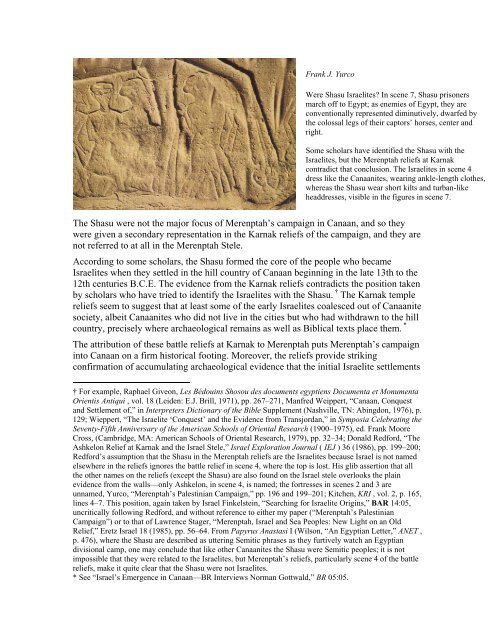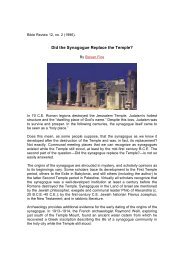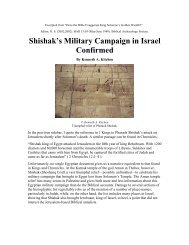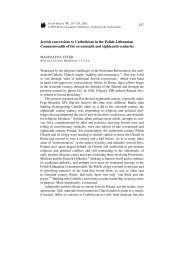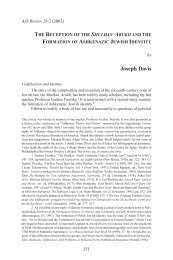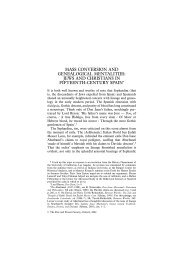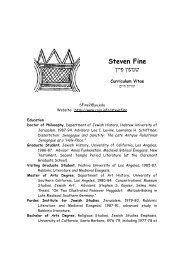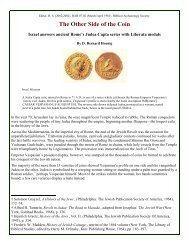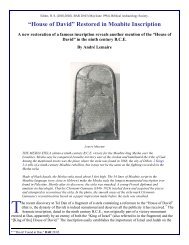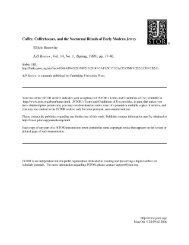3200-Year-Old Picture of Israelites Found in Egypt
3200-Year-Old Picture of Israelites Found in Egypt
3200-Year-Old Picture of Israelites Found in Egypt
You also want an ePaper? Increase the reach of your titles
YUMPU automatically turns print PDFs into web optimized ePapers that Google loves.
Frank J. Yurco<br />
Were Shasu <strong>Israelites</strong>? In scene 7, Shasu prisoners<br />
march <strong>of</strong>f to <strong>Egypt</strong>; as enemies <strong>of</strong> <strong>Egypt</strong>, they are<br />
conventionally represented dim<strong>in</strong>utively, dwarfed by<br />
the colossal legs <strong>of</strong> their captors’ horses, center and<br />
right.<br />
Some scholars have identified the Shasu with the<br />
<strong>Israelites</strong>, but the Merenptah reliefs at Karnak<br />
contradict that conclusion. The <strong>Israelites</strong> <strong>in</strong> scene 4<br />
dress like the Canaanites, wear<strong>in</strong>g ankle-length clothes,<br />
whereas the Shasu wear short kilts and turban-like<br />
headdresses, visible <strong>in</strong> the figures <strong>in</strong> scene 7.<br />
The Shasu were not the major focus <strong>of</strong> Merenptah’s campaign <strong>in</strong> Canaan, and so they<br />
were given a secondary representation <strong>in</strong> the Karnak reliefs <strong>of</strong> the campaign, and they are<br />
not referred to at all <strong>in</strong> the Merenptah Stele.<br />
Accord<strong>in</strong>g to some scholars, the Shasu formed the core <strong>of</strong> the people who became<br />
<strong>Israelites</strong> when they settled <strong>in</strong> the hill country <strong>of</strong> Canaan beg<strong>in</strong>n<strong>in</strong>g <strong>in</strong> the late 13th to the<br />
12th centuries B.C.E. The evidence from the Karnak reliefs contradicts the position taken<br />
by scholars who have tried to identify the <strong>Israelites</strong> with the Shasu. † The Karnak temple<br />
reliefs seem to suggest that at least some <strong>of</strong> the early <strong>Israelites</strong> coalesced out <strong>of</strong> Canaanite<br />
society, albeit Canaanites who did not live <strong>in</strong> the cities but who had withdrawn to the hill<br />
country, precisely where archaeological rema<strong>in</strong>s as well as Biblical texts place them. *<br />
The attribution <strong>of</strong> these battle reliefs at Karnak to Merenptah puts Merenptah’s campaign<br />
<strong>in</strong>to Canaan on a firm historical foot<strong>in</strong>g. Moreover, the reliefs provide strik<strong>in</strong>g<br />
confirmation <strong>of</strong> accumulat<strong>in</strong>g archaeological evidence that the <strong>in</strong>itial Israelite settlements<br />
† For example, Raphael Giveon, Les Bédou<strong>in</strong>s Shosou des documents egyptiens Documenta et Monumenta<br />
Orientis Antiqui , vol. 18 (Leiden: E.J. Brill, 1971), pp. 267–271, Manfred Weippert, “Canaan, Conquest<br />
and Settlement <strong>of</strong>,” <strong>in</strong> Interpreters Dictionary <strong>of</strong> the Bible Supplement (Nashville, TN: Ab<strong>in</strong>gdon, 1976), p.<br />
129; Wieppert, “The Israelite ‘Conquest’ and the Evidence from Transjordan,” <strong>in</strong> Symposia Celebrat<strong>in</strong>g the<br />
Seventy-Fifth Anniversary <strong>of</strong> the American Schools <strong>of</strong> Oriental Research (1900–1975), ed. Frank Moore<br />
Cross, (Cambridge, MA: American Schools <strong>of</strong> Oriental Research, 1979), pp. 32–34; Donald Redford, “The<br />
Ashkelon Relief at Karnak and the Israel Stele,” Israel Exploration Journal ( IEJ ) 36 (1986), pp. 199–200;<br />
Redford’s assumption that the Shasu <strong>in</strong> the Merenptah reliefs are the <strong>Israelites</strong> because Israel is not named<br />
elsewhere <strong>in</strong> the reliefs ignores the battle relief <strong>in</strong> scene 4, where the top is lost. His glib assertion that all<br />
the other names on the reliefs (except the Shasu) are also found on the Israel stele overlooks the pla<strong>in</strong><br />
evidence from the walls—only Ashkelon, <strong>in</strong> scene 4, is named; the fortresses <strong>in</strong> scenes 2 and 3 are<br />
unnamed, Yurco, “Merenptah’s Palest<strong>in</strong>ian Campaign,” pp. 196 and 199–201; Kitchen, KRI , vol. 2, p. 165,<br />
l<strong>in</strong>es 4–7. This position, aga<strong>in</strong> taken by Israel F<strong>in</strong>kelste<strong>in</strong>, “Search<strong>in</strong>g for Israelite Orig<strong>in</strong>s,” BAR 14:05,<br />
uncritically follow<strong>in</strong>g Redford, and without reference to either my paper (“Merenptah’s Palest<strong>in</strong>ian<br />
Campaign”) or to that <strong>of</strong> Lawrence Stager, “Merenptah, Israel and Sea Peoples: New Light on an <strong>Old</strong><br />
Relief,” Eretz Israel 18 (1985), pp. 56–64. From Papyrus Anastasi I (Wilson, “An <strong>Egypt</strong>ian Letter,” ANET ,<br />
p. 476), where the Shasu are described as utter<strong>in</strong>g Semitic phrases as they furtively watch an <strong>Egypt</strong>ian<br />
divisional camp, one may conclude that like other Canaanites the Shasu were Semitic peoples; it is not<br />
impossible that they were related to the <strong>Israelites</strong>, but Merenptah’s reliefs, particularly scene 4 <strong>of</strong> the battle<br />
reliefs, make it quite clear that the Shasu were not <strong>Israelites</strong>.<br />
* See “Israel’s Emergence <strong>in</strong> Canaan—BR Interviews Norman Gottwald,” BR 05:05.


